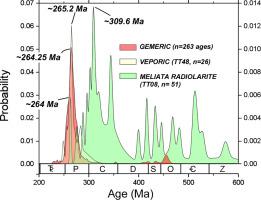Lithos ( IF 3.5 ) Pub Date : 2021-03-05 , DOI: 10.1016/j.lithos.2021.106083 Gabriel Villaseñor , Elizabeth J. Catlos , Igor Broska , Milan Kohút , Ľubomír Hraško , Kimberly Aguilera , Thomas M. Etzel , J. Richard Kyle , Daniel F. Stockli

|
The Gemeric and Veporic Superunits of the Western Carpathians correlate to the Lower and Middle Austroalpine tectonic units (nappes) of the Eastern Alps. The Gemeric Superunit is characterized by small exposures of rare-metal granites, and their ages impact understanding its tectonic history and how this portion of the Carpathians relates to other Permian age granites exposed throughout Europe and the Western Mediterranean. Here we present new Laser Ablation Inductively Coupled Plasma Mass Spectrometry (LA-ICP-MS) and Secondary Ion Mass Spectrometry (SIMS) zircon U--Pb ages from northern (Hnilec) and southern Gemeric granite exposures (Betliar, Elisabeth Mine, Poproč) and one from the Veporic Superunit (Klenovec). Geochemical analyses of Betliar and Klenovec samples indicate they are highly differentiated and fractionated from a clay-rich source, consistent with published reports for these granites. Zircon saturation temperatures average 733 ± 27 °C (Betliar) and 756 ± 61 °C (Klenovec). Most Gemeric granitic zircons are Permian (n = 231 spots), with some inherited zircons giving Middle Ordovician to Late Silurian (n = 26), and some Triassic (n = 6) U--Pb ages. The dominant Permian U--Pb yield crystallization ages of at 264 Ma for the Gemeric granite and 265 Ma for the Veporic Superunit's Klenovec granite (n = 26). Klenovec zircons typically show distinct yellow rims in cathodoluminescence, characteristic of lower temperature overprint (<600 °C). These granite zircon ages overlap those from the radiolarite-bearing metasediments from the Meliata Ocean exposed in the Dobšiná region (263.9 ± 2.7 Ma, LA-ICP-MS, ±1σ). The detrital zircon U--Pb ages thus imply a possible beginning of sedimentation in the Meliata Ocean as early as the mid-Permian. The genesis of the Gemeric and the Klenovec granites is related to post-collisional extension. These data link the Western Carpathians to a regional widespread occurrence of Permian magmatism in the European Variscan and Western Mediterranean realms, consistent with regional magmatic re-equilibration of the Moho. This scenario likely occurred in response to a thermal surge that involved significant decompression and extension, lower crustal melting, upward displacement of the Moho, and delamination of the mantle-lithosphere that contributed substantially towards Variscan crustal thinning.
中文翻译:

与瓦里斯卡造山运动(西喀尔巴阡山脉)后裂谷有关的二叠纪中期岩浆活动广泛的证据
西喀尔巴阡山脉的基因组和植物超单元与东阿尔卑斯山的下奥陶仑构造中部(尿布)相关。Gemeric Superunit的特征是少量暴露于稀有金属花岗岩中,其年龄会影响人们对其构造历史的了解,以及喀尔巴阡山脉的这一部分与整个欧洲和西地中海暴露的其他二叠纪时代花岗岩之间的关系。在这里,我们介绍了北部(Hnilec)和南部Gemeric花岗岩暴露(Betliar,Elisabeth Mine,Poproč)的新激光烧蚀电感耦合等离子体质谱(LA-ICP-MS)和二次离子质谱(SIMS)锆石U-Pb年龄。一支来自Veporic Superunit(Klenovec)。Betliar和Klenovec样品的地球化学分析表明,它们是从富含粘土的来源中高度分化并分离出来的,与这些花岗岩的已发布报告一致。锆石的饱和温度平均为733±27°C(Betliar)和756±61°C(Klenovec)。大部分的Gemeric花岗岩锆石是二叠纪的(n = 231个斑点),其中一些继承的锆石使中奥陶纪至晚志留纪(n = 26),还有三叠纪(n= 6)U–Pb年龄。Gemeric花岗岩的主要二叠系U-Pb产生结晶年龄为264 Ma,Veporic Superunit的Klenovec花岗岩的结晶年龄为265 Ma(n = 26)。Klenovec锆石通常在阴极发光中显示出明显的黄色边缘,这是较低温度叠印(<600°C)的特征。这些花岗岩锆石年龄与多布西纳州地区暴露于美丽雅海洋的含放射性云母的沉积物年龄重叠(263.9±2.7 Ma,LA-ICP-MS,±1σ)。因此,碎屑锆石的U-Pb年龄暗示早在二叠纪中期,Meliata海洋就有可能开始沉积。Gemeric和Klenovec花岗岩的成因与碰撞后的伸展有关。这些数据将西喀尔巴阡山脉与欧洲瓦里斯坎和西地中海地区的二叠纪岩浆活动在区域广泛发生,这与莫霍面的区域岩浆再平衡相一致。这种情况可能是由于热浪而发生的,热浪涉及大量的减压和伸展,地壳融化降低,Moho向上位移以及地幔-岩石圈的分层,这对Variscan地壳的变薄起到了很大的作用。


























 京公网安备 11010802027423号
京公网安备 11010802027423号